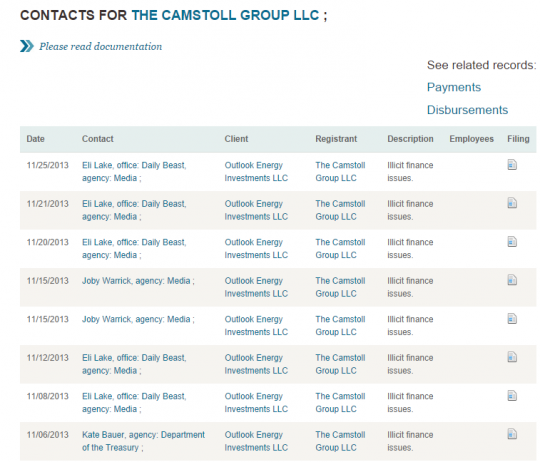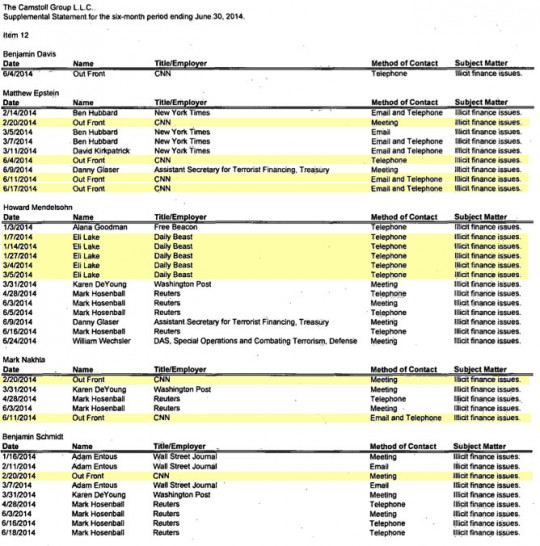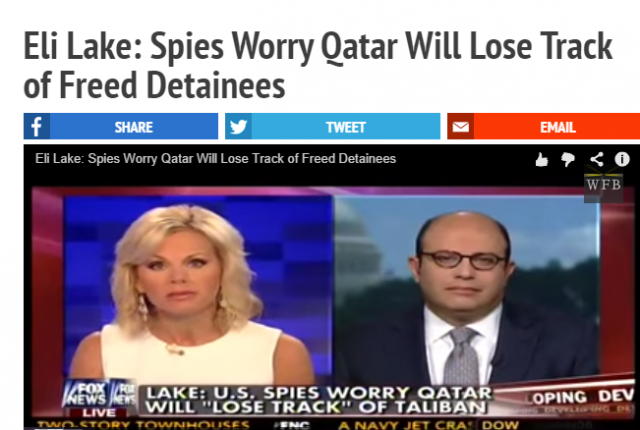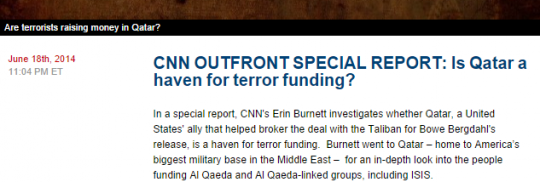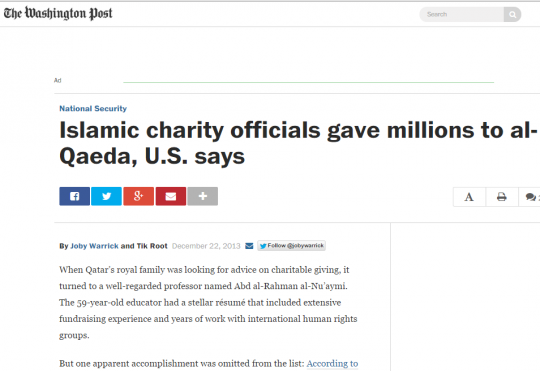How Former Treasury Officials and the UAE Are Manipulating American Journalists
MEDIA, 29 Sep 2014
Glenn Greenwald – The Intercept
Thu 25 Sep 2014 – (updated below [Fri. 26/9] – Update II [Fri.])
The tiny and very rich Persian Gulf emirate of Qatar has become a hostile target for two nations with significant influence in the U.S.: Israel and the United Arab Emirates. Israel is furious over Qatar’s support for Palestinians generally and (allegedly) Hamas specifically, while the UAE is upset that Qatar supports the Muslim Brotherhood in Egypt (UAE supports the leaders of the military coup) and that Qatar funds Islamist rebels in Libya (UAE supports forces aligned with Ghadaffi (see update below)).
This animosity has resulted in a new campaign in the west to demonize the Qataris as the key supporter of terrorism. The Israelis have chosen the direct approach of publicly accusing their new enemy in Doha of being terrorist supporters, while the UAE has opted for a more covert strategy: paying millions of dollars to a U.S. lobbying firm – composed of former high-ranking Treasury officials from both parties – to plant anti-Qatar stories with American journalists. That more subtle tactic has been remarkably successful, and shines important light on how easily political narratives in U.S. media discourse can be literally purchased.
This murky anti-Qatar campaign was first referenced by a New York Times article two weeks ago by David Kirkpatrick, which reported that “an unlikely alignment of interests, including Saudi Arabia, the United Arab Emirates, Egypt and Israel” is seeking to depict Doha as “a godfather to terrorists everywhere” (Qatar vehemently denies the accusation). One critical component of that campaign was mentioned in passing:
The United Arab Emirates have retained an American consulting firm, Camstoll Group, staffed by several former United States Treasury Department officials. Its public disclosure forms, filed as a registered foreign agent, showed a pattern of conversations with journalists who subsequently wrote articles critical of Qatar’s role in terrorist fund-raising.
How that process worked is fascinating, and its efficacy demonstrates how American public perceptions and media reports are manipulated with little difficulty.
The Camstoll Group was formed on November 26, 2012. Its key figures are all former senior Treasury Department officials in both the Bush and Obama administrations whose responsibilities included managing the U.S. government’s relationships with Persian Gulf regimes and Israel, as well as managing policies relating to funding of designated terrorist groups. Most have backgrounds as neoconservative activists. Two of the Camstoll principals, prior to their Treasury jobs, worked with one of the country’s most extremist neocon anti-Muslim activists, Steve Emerson.
Camstoll’s founder, CEO and sole owner, Matthew Epstein, was a Treasury Department official from 2003 through 2010, a run that included a position as the department’s Financial Attaché to Saudi Arabia and the UAE. A 2007 diplomatic cable leaked by Chelsea Manning and published by WikiLeaks details Epstein’s meetings with high-level Abu Dhabi representatives as they plotted to cut off Iran’s financial and banking transactions. Those cables reveal multiple high-level meetings between Epstein in his capacity as a Treasury official and high-level officials of the Emirates, officials who are now paying his company millions of dollars to act as its agent inside the U.S.
Prior to his Treasury appointment by the Bush administration, Epstein was a neoconservative activist, writing articles for National Review and working with Emerson’s aggressively anti-Muslim Investigative Project (Epstein’s published resume omits his work with Emerson). His pre-Treasury work for Emerson’s group, obsessed with The Muslim Threat Within, presaged Peter King’s 2011 anti-Muslim witch hunts.
In 2003, for instance, Epstein told the U.S. Senate that “large sections of the institutional Islamic leadership in America do not support U.S. counterterrorism policy” and that “the radicalization of the Islamic political leadership in the United States has developed parallel to the radicalization of the Islamic leadership worldwide, sharing a conspiratorial view that Muslims in the United States are being persecuted on the basis of their religion and an acceptance that violence in the name of Islam is justified.” He declared: “the rise of militant Islamic leadership in the United States requires particular attention if we are to succeed in the War on Terror.”
Camstoll’s Managing Director, Howard Mendelsohn, was Acting Assistant Secretary of Treasury, where he also had ample policy responsibilities involving the Emirates; a 2010 WikiLeaks cable details how he “met with senior officials from the UAE’s State Security Department (SSD) and Dubai’s General Department of State Security (GDSS)” to coordinate disruption of Taliban financing. Another Managing Director, Benjamin Schmidt, worked with Epstein at Emerson’s Investigative Project before his own appointment to Treasury; a 2009 diplomatic cable shows him working with Israel on controlling financing to Palestinians. A Camstoll director, Benjamin Davis, was the Treasury Department’s Financial Attaché in Jerusalem.
On December 2, 2012 – less than a week after Camstoll was incorporated – it entered into a lucrative, open-ended consulting contract with an entity wholly owned by the Emirate of Abu Dhabi, Outlook Energy Investments, LLC (its Emir, the President of UAE, is pictured above). A week later, Camstoll registered as a foreign agent working on behalf of the Emirate. The consultancy agreement calls for Camstoll to be paid a monthly fee of $400,000, wired each month into a Camstoll account. Two weeks after it was formed, Camstoll was paid by the Emirates entity a retainer fee of $4.3 million, and then another $3.2 million in 2013.
In other words, a senior Treasury official responsible for U.S. policy toward the Emirates leaves the U.S. government and forms a new lobbying company, which is then instantly paid millions of dollars by the very same country for which he was responsible, all to use his influence, access and contacts for its advantage. The UAE spends more than any other country in the world to influence U.S. policy and shape domestic debate, and it pays former high-level government officials who worked with it – such as Epstein and his company – to carry out its agenda within the U.S.
What did Camstoll do for these millions of dollars? They spent enormous of amounts of time cajoling friendly reporters to plant anti-Qatar stories, and they largely succeeded. Their strategy was clear: target neocon/pro-Israel writers such as the Daily Beast‘s Eli Lake, Free Beacon‘s Alana Goodman, Iran-contra convict Elliott Abrams, The Washington Post‘s Jennifer Rubin, and American Enterprise Institute’s Michael Rubin – all eager to promote the Qatar-funds-terrorists line being pushed by Israel. They also targeted establishment media figures such as CNN’s Erin Burnett, Reuters’ Mark Hosenball, and The Washington Post‘s Joby Warrick.
In the latter half of 2013, Camstoll reported 15 separate contacts with Lake, all on behalf of UAE’s agenda; in the month of December alone, there were 10 separate contacts with Goodman. They also spoke multiple times with Warrick. At the same time, they were speaking on behalf of their Emirates client with their former colleagues who were still working as high-level Treasury officials, including Kate Bauer, the Treasury Department’s Emirates-based Financial Attaché, and Deputy Assistant Secretary Danny McGlynn.
In the first half of 2014, as the Emirates attack on Qatar intensified, Camstoll spoke multiple times with Lake, Hosenball, and Erin Burnett’s CNN show “Out Front,” and had conversations with Goodman and the NYT‘s David Kirkpatrick. They continued to meet with high-level Treasury officials as well, including Assistant Secretary for Terrorist Financing Daniel Glaser (highlights added):
This work paid dividends for the UAE. In June, when the Obama administration announced a plan to release Guantanamo detainees to Qatar, Lake published a widely cited Daily Beast article depicting Qatar as friends of the terrorists; it quoted anonymous officials as claiming that “many wealthy individuals in Qatar are raising money for jihadists in Syria every day” and “we also know that we have sent detainees to them before, and their security services have magically lost track of them.” Lake himself pronounced that “Qatar’s track record is troubling” and that “the emirate is a good place to raise money for terrorist organizations.”
He then went on Fox News and said that “there still is a major issue with just terrorist financing in Qatar” and that in Doha there are “individuals who are roaming free who have raised a lot of money for al Qaeda, Hamas and other groups like that.”
Meanwhile, CNN sent Burnett to Doha where she broadcast a “special report” entitled: “Is Qatar a haven for terror funding”? CNN touted it as “an in-depth look into the people funding Al Qaeda and Al Qaeda-linked groups, including ISIS.” She began her report by noting that “the terror group ISIS is committing atrocities in Iraq. The Iraqi prime minister Nouri al-Maliki blames Saudi Arabia and Qatar for providing ISIS militants with money and weapons.” She then put on a source, former Bush deputy national security adviser and Treasury official Juan Zarate, to say that “Qatar is at the center of this. Qatar has now taken its place in the lead of countries that are supporting al Qaeda and al Qaeda-related groups.”
On camera, Burnett asked her source: “So how high up in the government in Qatar does the support for Islamic extremism for these al Qaeda-linked groups go?” The answer: “Well, these are decisions made at the top. So Qatar operates as a monarchy. Its officials, its activities follow the orders of the government. And to the extent that there’s a policy of supporting extremists in the region, that’s a policy that comes from the top.” She then brought on the GOP Chairman of the House Homeland Security Committee, Michael McCaul, and asked whether he agrees that “money out of Qatar could end up being used to fuel the ambition, the dream, of attacks against the United States directly,” and he quickly said he did.
Camstoll’s work with the Post‘s Warrick also proved quite productive. Camstoll spoke with Warrick on December 17, 2013. The very next day, the Post reporter published an article stating that “private Qatar-based charities have taken a more prominent role in recent weeks in raising cash and supplies for Islamist extremists in Syria, according to current and former U.S. and Middle Eastern officials.”
Camstoll representatives spoke again with Warrick on December 20 and December 21. The day after, he published another more accusatory article citing “increasing U.S. concern about the role of Qatari individuals and charities in supporting extreme elements within Syria’s rebel alliance” and linking the Qatari royal family to a professor and U.S. foreign policy critic alleged by the U.S. government to be ”working secretly as a financier for al-Qaeda.”
As one of his sources, Warrick in the first of his articles cited “a former U.S. official who specialized in tracking Gulf-based jihadist movements and who spoke on the condition of anonymity because much of his work for the government was classified.” That perfectly describes several Camstoll Group members, though Warrick did not respond to questions from The Intercept about whether this anonymous source was indeed a paid agent of the UAE working at Camstoll.
Also on Camstoll’s list of journalistic contacts was Kirkpatrick, who produced the article in the NYT two weeks ago headlined “Qatar’s Support of Islamists Alienates Allies Near and Far.” It noted that Qatar “has tacitly consented to open fund-raising” for Al Qaeda affiliates.
But unlike all the other reports helpfully produced by Camstoll’s journalistic allies, Kirkpatrick expressly described, and cast skeptical light on, the concerted campaign to focus on Qatar, not only mentioning Camstoll’s behind-the-scenes work but also reporting that “Qatar is finding itself under withering attack by an unlikely alignment of interests, including Saudi Arabia, the United Arab Emirates, Egypt and Israel, which have all sought to portray it as a godfather to terrorists everywhere.” Kirkpatrick also noted that “some in Washington have accused it of directly supporting the Islamic State in Iraq and Syria,” a claim he called “implausible and unsubstantiated.”
In response to questions from The Intercept about Camstoll’s role in his reporting, Lake refused to answer any questions, stating: “I don’t talk about how I do my reporting. I meet with many representatives and officials of foreign governments in the course of my job.” (So many journalists pride themselves on demanding transparency and accountability from others while adopting a posture of absolute secrecy for their own work that would make even a Pentagon spokesperson blush: “I don’t talk about how I do my reporting”). Goodman similarly said: “as I’m sure you understand, I can’t discuss my private conversations with contacts.” Camstoll’s contacts with Goodman and Hosenball appear to have produced no identifiable reports. Camstoll, Warwick, and Hosenball all provided no response to questions from The Intercept.
The point here is not that Qatar is innocent of supporting extremists. Nor is it a reflection on any inappropriate conduct by the journalists, who are taking information from wherever they can get it (although one would certainly hope that, as Kirkpatrick did, they would make clear what the agenda and paid campaign behind this narrative is).
The point is that this coordinated media attack on Qatar – using highly paid former U.S. officials and their media allies – is simply a weapon used by the Emirates, Israel, the Saudis and others to advance their agendas. Kirkpatrick explained: ”propelling the barrage of accusations against Qatar is a regional contest for power in which competing Persian Gulf monarchies have backed opposing proxies in contested places like Gaza, Libya and especially Egypt.” As political science professor As’ad AbuKhalil wrote this week about conflicts in Syria and beyond, “the two Wahhabi regimes [Saudi Arabia and Qatar] are fighting over many issues but they both wish to speak on behalf of political Islam.”
What’s misleading isn’t the claim that Qatar funds extremists but that they do so more than other U.S. allies in the region (a narrative implanted at exactly the time Qatar has become a key target of Israel and the Emirates). Indeed, some of Qatar’s accusers here do the same to at least the same extent, and in the case of the Saudis, far more so. As Kirkpatrick noted: “Qatar is hardly the only gulf monarchy to allow open fund-raising by sheikhs that the United States government has linked to Al Qaeda’s Syrian franchise, the Nusra Front: Sheikh Ajmi and most of the others are based in Kuwait and readily tap donors in Saudi Arabia, sometimes even making their pitches on Saudi- and Kuwaiti-owned television networks.”
One U.S. government cable from 2009, also published by WikiLeaks, identified Saudi Arabia, not Qatar, as the greatest danger in this regard:
Donors in Saudi Arabia constitute the most significant source of funding to Sunni terrorist groups worldwide.
The writer of that cable complained that “it has been an ongoing challenge to persuade Saudi officials to treat terrorist financing emanating from Saudi Arabia as a strategic priority.”
Prior to his appointment as a Treasury official – and before he began working as a paid agent of the UAE to finger Qatar as the key threat – Camstoll’s founder and CEO, Epstein, himself fingered Saudis as the key financiers of Al Qaeda and anti-American terrorism. His 2003 Senate testimony included this statement: “the Saudi Wahhabists have bankrolled a series of Islamic institutions in the United States that actively seek to undermine U.S. counterterrorism policy at home and abroad”; he added: “in the United States, the Saudi Wahhabis regularly subsidize the organizations and individuals adhering to the militant ideology espoused by the Muslim Brotherhood and its murderous offshoots Hamas, Palestinian Islamic Jihad and al-Qaeda, all three of which are designated terrorist.”
While the 2009 cable claimed claimed that ”Qatar’s overall level of CT cooperation with the U.S. is considered the worst in the region,” it said this was “out of concern for appearing to be aligned with the U.S. and provoking reprisals.” But the cable also identified other U.S. allies in the region as key conduits for terrorist financing, stating, for instance, that “Al-Qa’ida and other groups continue to exploit Kuwait both as a source of funds and as a key transit point.” It also heavily implicated the Emirates themselves: ”UAE-based donors have provided financial support to a variety of terrorist groups, including al-Qa’ida, the Taliban, LeT and other terrorist groups, including Hamas.”
One of the most critical points illustrated by all of this tawdry influence-peddling is the alignment driving so much of US policy in that region. The key principals of Camstoll have hard-core neoconservative backgrounds. Here they are working hand in hand with neocon journalists to publicly trash a new enemy of Israel, in service of the agenda of Gulf dictators. This is the bizarre neocon/Israel/Gulf-dictator coalition now driving not only U.S. policy but, increasingly, U.S. discourse as well.
UPDATE [Fri.]: It’s obviously ancillary to the article, but several people have raised valid objections about the claim here that the forces in Libya now being supported by the UAE are accurately characterized as Gadaffi loyalists, arguing that the UAE supported anti-Gadaffi rebels during the NATO intervention and many they now support are still opposed to Gadaffi loyalists. The evidence for the original reference is found in articles such as this one, describing how those UAE-supported factions are fighting with “many pro-Gaddafi prisoners” who have been released. But those raising the question are right that the description is an over-simplification about the groups fighting in Libya who are supported by the UAE. The important point is that Qatar and the UAE are supporting different factions, but it’s more complex than the phrase “supports forces aligned with Ghadaff” suggested.
UPDATE II [Fri.]: Prior to publication of this article, Lake categorically refused to talk about his reporting in response to questions from The Intercept (“I don’t talk about how I do my reporting”). He has now apparently changed his mind, claiming today on Twitter:
I spoke to no camstoll officials for this piece http://www.thedailybeast.com/articles/2014/06/05/u-s-spies-worry-qatar-will-magically-lose-track-of-released-taliban.html … as @ggreenwald implies in his piece.
Lake does not deny the more-than-a-dozen contacts with Camstoll, nor, when asked, would he deny that he spoke with them about Qatari funding of or support for terrorism prior to his article (indeed, he expressly said he is not denying that). Nor has he contested any of the specific claims actually made here. Everyone should review the evidence presented – both here and in Kirkpatrick’s original NYT article – and decide for themselves what it shows.
______________________________
Margot Williams and Andrew Fishman contributed additional reporting
Photo: Sheik Khalifa bin Zayed Al Nahyan, president of the United Arab Emirates (Murat Cetinmuhurdar/Turkish Presidency Press Office/AP)
Email the author: glenn.greenwald@theintercept.com
Go to Original – firstlook.org
DISCLAIMER: The statements, views and opinions expressed in pieces republished here are solely those of the authors and do not necessarily represent those of TMS. In accordance with title 17 U.S.C. section 107, this material is distributed without profit to those who have expressed a prior interest in receiving the included information for research and educational purposes. TMS has no affiliation whatsoever with the originator of this article nor is TMS endorsed or sponsored by the originator. “GO TO ORIGINAL” links are provided as a convenience to our readers and allow for verification of authenticity. However, as originating pages are often updated by their originating host sites, the versions posted may not match the versions our readers view when clicking the “GO TO ORIGINAL” links. This site contains copyrighted material the use of which has not always been specifically authorized by the copyright owner. We are making such material available in our efforts to advance understanding of environmental, political, human rights, economic, democracy, scientific, and social justice issues, etc. We believe this constitutes a ‘fair use’ of any such copyrighted material as provided for in section 107 of the US Copyright Law. In accordance with Title 17 U.S.C. Section 107, the material on this site is distributed without profit to those who have expressed a prior interest in receiving the included information for research and educational purposes. For more information go to: http://www.law.cornell.edu/uscode/17/107.shtml. If you wish to use copyrighted material from this site for purposes of your own that go beyond ‘fair use’, you must obtain permission from the copyright owner.
